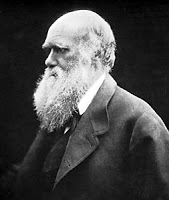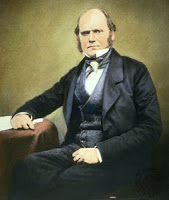” Darwin himself never claimed to provide proof of evolution or of the origin of species. His claim was that if evolution had occurred, a number of otherwise mysterious facts about plants and animals could be easily explained. After his death, however, direct evidence of evolution was observed, and evolution is now supported by a wealth of evidence from a variety of scientific fields.
The theory of evolution by natural selection that was developed by Charles Darwin revolutionized the study of living things. In his Origin of Species (1859) he provided a scientific explanation of how the diverse species of plants and animals have descended over time from common ancestors. His theory remains central to the foundations of modern biology. Moreover, by demonstrating how natural laws govern the world of living things, Darwin helped usher in a new era in the cultural and intellectual history of humankind.
Charles Robert Darwin was born in Shrewsbury, England, on Feb. 12, 1809. Darwin‘s father was a successful and wealthy physician; his mother was a daughter of Josiah Wedgwood, the famous British potter. She died when Charles was eight years old, and the boy was reared by three older sisters, who constantly found fault with him.
Darwin was such an indifferent student that his father said, “You care for nothing but shooting, dogs, and rat-catching, and you will be a disgrace to yourself and all your family.” He had no interest in the classical languages and ancient history taught in school. Instead, he liked to collect shells, birds’ eggs, and coins. He also watched birds and insects and helped his brother make chemical exp eriments at home.
eriments at home.
At the age of 16, Darwin began to study medicine at the University of Edinburgh. There too he found the courses dull, and watching operations made him ill. In 1828 he transferred to Cambridge, intending to become a clergyman. Instead, he devoted most of his time to studying plants and animals and later to geology. He received his bachelor’s degree in 1831.
Then came the event that shaped his life—an appointment as unpaid naturalist on the exploring ship Beagle. It left England on Dec. 27, 1831, to chart the southern coasts of South America and sail around the world. The voyage, with many side trips on land, lasted until October 1836. During those five years Darwin examined geologic formations, collected fossils, and studied plants and animals. In the jungles, mountains, and islands he visited, he saw evidence of the many geologic changes that have been occurring over the course of eons—for example, the land gradually rising in some places and falling in others. He also considered the great diversity of living things, even in the depths of the ocean where no humans could appreciate their beauty. He thought about how the fossils he collected suggested that some kinds of mammals had died out. And he returned home filled with questions.
Back home, Darwin settled in London and quietly began work on what would become his great theory of evolution, developed largely in 1837–39. Meanwhile, he wrote up the Journal of his scientific work on the Beagle. He also consulted experts to help him identify the thousands of fossils and specimens he had brought back, and he published the results. In 1839 he was admitted to the prestigious Royal Society.
Darwin married his cousin Emma Wedgwood in 1839, and they eventually had 10 children. He began to avoid society, and in 1842 the couple moved to the isolated village of Downe. This was partly owing to physical illness: a few years earlier, Darwin had begun to experience the heart palpitations and nausea that would plague him for the rest of his life. But he also sought seclusion because he knew that his radical theory would shock and offend Victorian society. Believing in evolution, Darwin said, was “like confessing a murder.” And so he continued thi
shock and offend Victorian society. Believing in evolution, Darwin said, was “like confessing a murder.” And so he continued thi
In Darwin‘s time, the nearly universally accepted view was that God had created all species of living things in their current forms and that their attributes were the result of God’s design. Nevertheless, Darwin was not the first to suggest that living things might change over time. Since ancient times, people have proposed other ways that plants and animals could have developed. The first broad theory of evolution was proposed in the early 19th century by French naturalist Jean-Baptiste Lamarck. He maintained that plants and animals evolved because of an inborn tendency to progress from simple to complex forms. Environment, however, modified this progression and so did use or disuse of parts. He thought that giraffes, for example, developed long necks by straining to reach the leaves of trees, while snakes lost their legs by crawling.
Darwin knew about Lamarck’s theory of evolution. His grandfather, Erasmus Darwin, had published several books expounding similar ideas. He felt, however, that early writers on the subject had speculated too much and had not based their theories on a solid foundation of observable phenomena. In developing his theory of evolution, Darwin drew upon observations made in a wide array of scientific disciplines and conducted a great many experiments.
Darwin also happened to read An Essay on the Principle of Population, by British economist Thomas Malthus. Malthus had undertaken to prove that human populations tend to increase more rapidly than food and other necessities. The result is a struggle in which some people succeed and become wealthy while others fail or even starve.
Darwin applied this theory to the world of nature. Plants and animals, he knew, reproduce so rapidly that the Earth could not hold them if all their young survived. This meant that there was a constant struggle for space, food, and shelter, as well as against enemies and unfavorable conditions. Certain hawks, for example, struggle, or compete, with each other for the mice they eat, and the poorest hunters go hungry. Mice, in turn, struggle to keep from being caught by hawks. In frigid winters living things struggle against the cold. Some endure it, while others fail to keep themselves warm enough and die. Although Darwin did not coin the phrase “survival of the fittest,” his ideas about struggle expressed the same notion.
Struggling and living or dying could not lead to evolution if all members of each living kind or species were exactly alike. Darwin found that members of a single species vary greatly in shape, size, color, strength, and so on. He also believed that most of these variations could be inherited.
Under the constant struggle to exist, organisms with harmful variations are more likely to die before they can reproduce. And, on average, living things with useful variations are more likely to survive and bear young and thus to pass on their helpful variations. When their descendants vary still more, the process is repeated. In other words, the struggle for existence selects organisms with helpful variations but makes others die out. Darwin called this process natural selection.
Over the ages, Darwin believed, changes from natural selection produce a slow succession of new plants, animals, and other organisms. These changes have enabled living things to go into all sorts of environments and become fitted, or adapted, to many different types of life. Darwin called his theory descent by modification, because he proposed that all living things were descended from earlier forms.
Darwin wrote a short sketch of his theory in 1842 and a longer one in 1844. Instead of publishing the second statement, however, he continued his investigations. He also wrote books on coral reefs, volcanic islands, barnacles, and the geology of South America. Not until 1856 did he begin what would be a multivolume work on evolution.
In 1858 he received a manuscript from a young naturalist, Alfred Russel Wallace, who also had developed a theory of natural selection. With Wallace’s approval, short statements by both men were published late in 1858. Darwin went on to write his famous book On the Origin of Species by Means of Natural Selection, which appeared in 1859.
The book caused a tremendous stir, and not just in scientific circles. The general public also read, discussed, and vigorously defended or denounced Darwin‘s theory, which became a popular topic in society salons. Some religious leaders believed that evolution was incompatible with their teachings and so opposed it. Newspapers publicized with great scorn a conclusion that Darwin had been careful to avoid—that humans are descended from apes. Evolutionary imagery spread through many other fields, including literature, economics, and political and social science. During Darwin‘s lifetime, the scientific community largely accepted his theory of descent, though it was slower to adopt his idea of natural selection.
After completing the Origin of Species, Darwin began The Variation of Animals and Plants Under Domestication, which showed how rapidly some organisms had evolved under artificial selection, the selective breeding of plants and animals by humans. The Descent of Man, and Selection in Relation to Sex, published in 1871, discussed human evolution. Later books dealt with earthworms, orchids, climbing plants, and plants that eat insects.
Darwin became very weak in 1881 and could no longer work. He died on April 19, 1882, in Downe, and was buried in Westminster Abbey among England’s greatest citizens.
Darwin himself never claimed to provide proof of evolution or of the origin of species. His claim was that if evolution had occurred, a number of otherwise mysterious facts about plants and animals could be easily explained. After his death, however, direct evidence of evolution was observed, and evolution is now supported by a wealth of evidence from a variety of scientific fields.
Evolution has been rejected by members of some religious groups who prefer their theory of creationism. This attempts to explain some features of plant and animal life through a literal interpretation of the Bible. In the scientific community, however, there is little doubt that the general outline of Darwin‘s theory of evolution is correct.
To cite this page:
- MLA Style: “Darwin, Charles.” Britannica Student Library. Encyclopædia Britannica 2009 Student and Home Edition. Chicago: Encyclopædia Britannica, 2009.
- APA Style: Darwin, Charles. (2009). Britannica Student Library. Encyclopædia Britannica 2009 Student and Home Edition. Chicago: Encyclopædia Britannica.






